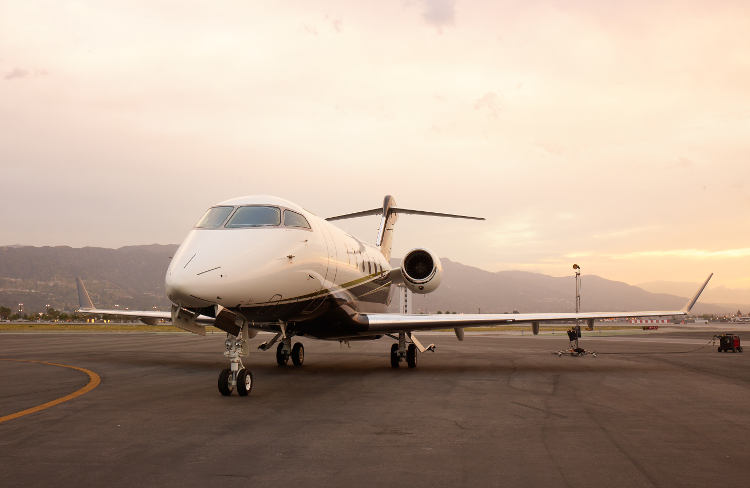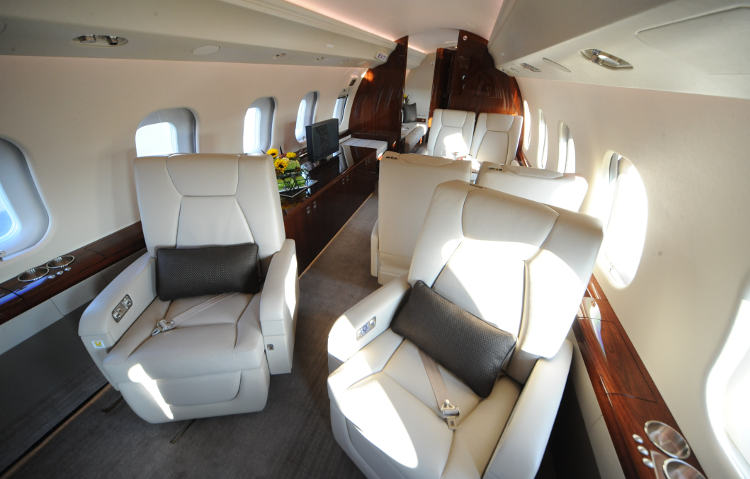Flexjet and NetJets, two private aviation sector giants, are both backed by firms run by some of the world’s savviest investors. They have developed similar luxury private jet ownership and card programs, that can be difficult to distinguish between. Here’s a closer look at how they compare.
History & Background
Originally launched as a collaboration between Bombardier and AMR Combs (a division of AMR Corp, the parent company of American Airlines) in 1995, Flexjet was acquired in 2013 by entrepreneur Kenn Ricci. Ricci’s firm, Directional Aviation Capital, also owns Skyjet, Sentient Jet, and Flight Options. The company is now the world’s second-largest fractional jet ownership services provider. It’s known for its focus on a tightly managed fleet of young aircraft, with an average age of five-six years.
Though others claim to have invented the jet card concept, NetJets is the undisputed originator of the fractional ownership model. The company was established in 1964 as Executive Jet Aviation, and was bought—and renamed NetJets—by Goldman Sachs exec Richard Santulli in 1984. Santulli used his background as a mathematician to analyze 22 years’ worth of pilot logbooks in developing his concept, which started out with 10 Learjet aircraft. The company, which is now a subsidiary of Warren Buffets Berkshire Hathaway, currently has a fleet of 700 aircraft worldwide. All jets are owned and operated by NetJets.

Aircraft
Flexjet offers private jets across all the size categories. Their fleet includes:
Light and Super-Light Cabin
- Embraer Phenom 300—up to 6 passengers; 74 cubic feet baggage capacity; 3,196 km range. One of the most requested aircraft for private travel, thanks to its comfortable interior.
- Learjet 75LXI—up to 6 passengers; 50 cubic feet baggage capacity; 3,299 km range. This jet boasts more legroom, a flat floor, and a high-tech cabin-management system, as well as improved aerodynamics for better performance in hot climates and high altitudes.
Midsize and Super-Midsize Cabin
- Embraer Legacy 450—up to 8 passengers; 150 cubic feet baggage capacity; 5,370 km range. A spacious midsize jet, the Legacy has a stand-up cabin and flat floor, as well as enlarged luggage capacity.
- Bombardier Challenger 300—up to 9 passengers; 106 cubic feet baggage capacity; 5,552 km range. Spacious and comfortable, this jet is capable of flying transcontinental distances.
- Bombardier Challenger 350—up to 9 passengers; 106 cubic feet baggage capacity; 6,047 km range.
Large Cabin
- Gulfstream G450—up to 13 passengers; 169 cubic feet baggage capacity; 7,242 km range. A top choice for intercontinental flights.
Ultra-Long Range
- Gulfstream G500—up to 16 passengers; 175 cubic feet baggage capacity; 9,630 km range. This jet is capable of traveling at Mach .90, combining incredible speed with long range.
- Bombardier Global Express—up to 12 passengers; 185 cubic feet baggage capacity; 11,080 km range. Special attention to space, luxury, and technology give this jet an edge in long-range business travel
- Gulfstream G650—up to 16 passengers; 195 cubic feet baggage capacity; 12,964 km range. Known for having the lowest-pressurized cabin altitude of all business aircraft.
The NetJets fleet includes:
Light Cabin
- Cessna Citation Encore—up to 7 passengers; 69 cubic feet baggage capacity; 3,122 km range. Built to climb faster to altitude, for a more comfortable ride and additional range.
- Embraer Phenom 300—up to 6 passengers; 74 cubic feet baggage capacity; 3,196 km range. One of NetJets’ most requested aircraft, thanks to its comfortable interior.
- Cessna Citation Excel/XLS—up to 7 passengers; 79 cubic feet baggage capacity; 3,441 km range. Offers the amenities of a midsize-cabin jet with the ability to fly into and out of smaller airports.
Midsize Cabin
- Hawker 900XP—up to 8 passengers; 40 cubic feet baggage capacity; 5,153 km range. Nicknamed the “spacious conference room in the sky,” the Hawker is known for its comfortable cabin and speed.
- Cessna Citation Latitude—up to 7 passengers; 100 cubic feet baggage capacity; 4,937 km range. This midsize jet measures 6 feet in cabin height and has the largest cross-section in NetJets’ midsize class.
- Cessna Citation Sovereign—up to 8 passengers; 100 cubic feet baggage capacity; 5,219 km range. Able to fly longer ranges in high elevations.
Super-Midsize Cabin
- Cessna Citation X—up to 8 passengers; 72 cubic feet baggage capacity; 5,476 km range. This nimble aircraft is reputed to reduce cross-country travel by up to 35 minutes.
- Bombardier Challenger 350—up to 9 passengers; 106 cubic feet baggage capacity; 6,047 km range.
Large Cabin & Ultra-Long Range
- Dassault Falcon 2000/2000EX—up to 10 passengers; 134 cubic feet baggage capacity; 5,429 km range. This aircraft mixes business with pleasure, offering flexible conference and club seating and a comfortable large-cabin feel.
- Bombardier Challenger 650—up to 11 passengers; 115 cubic feet baggage capacity; 6,833 km range. Considered a world-class large-cabin jet, the Challenger 650 provides optimal comfort and mobility during coast-to-coast and even intercontinental flights.
- Gulfstream IV-SP/G450—up to 13 passengers; 169 cubic feet baggage capacity; 7,242 km range. Another great choice for intercontinental flights.
- Bombardier Global 5000—up to 13 passengers; 195 cubic feet baggage capacity; 10,452 km range. Designed for premium comfort, this large-cabin aircraft is a popular choice for transatlantic trips.
- Gulfstream G550—up to 14 passengers; 226 cubic feet baggage capacity; 11,975 km range. A descendant of the Gulfstream V, this is an ultra-long-range business jet.
- Bombardier Global 6000—up to 13 passengers; 195 cubic feet baggage capacity; 11,632 km range. Known for its transpacific performance, this speedy jet has long range.

Availability
For fractional ownership, Flexjet requires 10 hours’ call-out time. For its Jet Card program, a full 24 hours are needed and 48 hours are needed for peak hours.
NetJets Fractional Owners are required to give 4 to 6 hours’ notice for booking. There are 15 peak period days; 48 hours’ notice is required for travel on these days.
For NetJets Marquis Jet Cards, plan on 10 hours’ notice. There are 30 to 45 peak days, with 120 hours’ notice required during peak days. FET is excluded from the overall price, and flights are subject to a fuel surcharge.
NetJets Elite Jet Cards, which are limited to its two Citation light jets, are offered in 25-hour blocks. Twenty-four hours’ notice is required on most days, and there are 45 peak days per year with a 120-hour minimum booking notice. A 25% premium is assessed for hours on peak days with the Elite card, unlike with the Marquis card, but Elite pricing includes FET and fuel.
For all three NetJets programs, downgrades are guaranteed, and upgrades are subject to availability, within 24 hours of making a request. Card program members can also expect extra fees for international, ground transportation, and other miscellaneous charges.
Hours, Memberships, and Pricing
Flexjet is tight-lipped on pricing, but, like most private aviation companies, recommends fractional ownership for those who fly 50 or more hours per year. In addition to an initiation fee, count on monthly management fees for maintenance, trip management, crew staffing, and administrative costs, as well as an hourly fee that includes the cost of fuel.
Flexjet also offers a program to fractional owners called Versatility Plus, which allows them to make unused hours available to other owners, or purchase additional hours from other owners. In addition, their Global Access pricing reduces the hourly rate as the length of the trip increases, to help offset the higher costs of cross-country and intercontinental travel.
The Flexjet 25 card, which starts around $160,000, is made for those who fly fewer than 50 hours per year and prefer to eschew an up-front investment. The site touts 365-day, guaranteed access to two aircraft (the Phenom 300 and Challenger 300), but notes that additional fees may apply during peak travel days.
Owners and card members of Flexjet are provided with a variety of premium perks, from access to private golf clubs to travel and spa packages, plus elite travel status with its international commercial partners.
NetJets Ownership allows you to purchase a minimum of a 1/16 interest in a specific aircraft, equivalent to 50 hours’ of flight time per year (the overall price varies by aircraft and flight frequency). There’s a one-time acquisition cost, plus a monthly management fee and an occupied hourly fee for fuel, maintenance, catering, and landing. After the minimum term, NetJets offers a guaranteed buy-back option if you opt out of the program.
Made for travelers who fly fewer than 50 hours per year, NetJets Marquis Jet Cards offer prepaid access to the aircraft of your choice. You’re guaranteed 25 hours at a time over 18 months, with the flight time deducted from your card balance. Pricing starts in the neighborhood of $165,000.
NetJets is constantly adding to its lifestyle benefits program, from private parties at sports and cultural events to private concerts, complimentary car rentals, special pricing on accommodations at luxury resorts, and even unique vacation packages.
Terms
The Flexjet 25 card has a 24-month term, while the fractional ownership contract runs from 30 to 60 months. NetJets Ownership has a minimum term of 36 months; its Marquis Jet Card and Elite Card run for 18-months.
Deciding between Flexjet and NetJets, with their similar membership structure, terms, and aircraft types comes down to several components including costs and especially the specific types of aircraft you’ll have access to. Do you lean toward NetJets’ larger fleet, or is Flexjet’s younger jet collection more appealing?
Both offer fractional ownership and jet cards. NetJets has a larger fleet, Flexjet is slightly newer. Both have a range of planes with some overlap and some unique planes.

